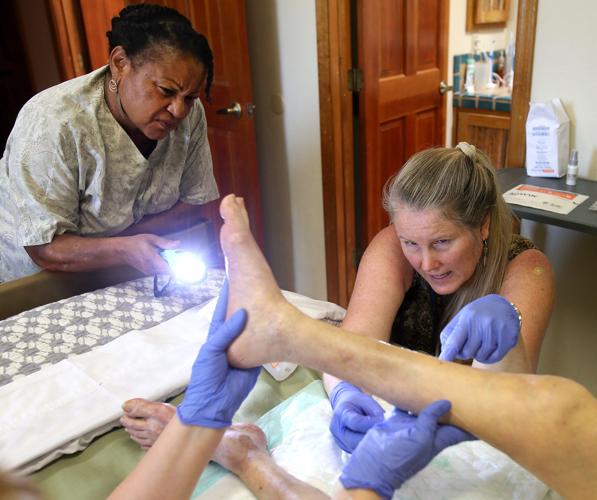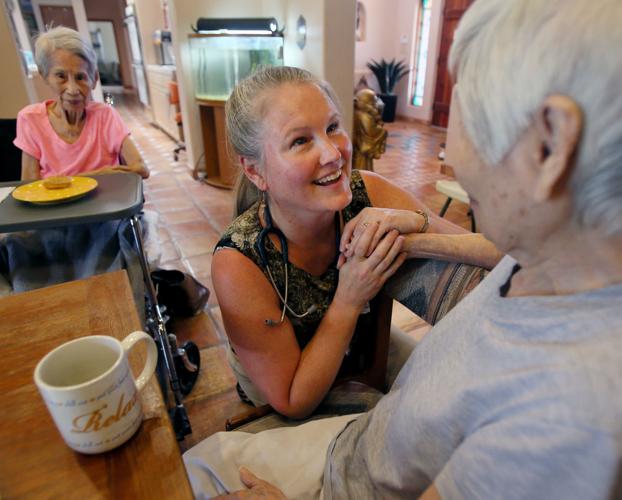Taking her elderly mother and aunt to the doctor is a complicated process for Tucson resident Jennifer Gin.
Both sisters, who live with Gin, require wheelchairs and have dementia. When taking them to the doctor, tasks like getting them in and out of the car, finding parking and sitting in the waiting room require careful coordination.
But Gin’s family has not had to worry about those stressful trips for an entire year. Medical care for 96-year-old Florence Quen and her 94-year-old sister Ruth Yang, including services like lab testing and X-rays, now comes to them.
Such care could become more widespread with the passage of a bill pending in Congress that would provide home care to the sickest 5 percent of Medicare patients — the ones who use 50 percent of the federal program’s dollars.
In particular, the bill targets people suffering from multiple debilitating diseases such as Alzheimer’s, ALS, congestive heart failure, diabetes and Parkinson’s.
Independence at home
A small, fledgling program through Banner Health is bringing home medical visits to certain chronically ill patients in Tucson, including Quen and Yang.
The program, which aims to prevent hospitalizations, long-term-care admissions and emergency room visits, also coordinates services like wound care at home.
The Senate bill introduced in Congress this summer would broaden the scope of home visits by turning a team-based home-care model into a national Medicare program. The legislation doesn’t specify who is on the team. It is interdisciplinary and can include physical therapists, occupational therapists, office coordinators and pharmacists, among others.
It would make permanent a demonstration project called Independence at Home that the U.S. Centers for Medicare & Medicaid Services has funded in some places — but none in Arizona — since 2012.
Independence at Home provides Medicare beneficiaries who have multiple chronic conditions with home-based medical care by a team, including a physician or nurse practitioner and a social worker.
The program has resulted in a savings for Medicare, officials say — $10 million in its second year, when nearly 11,000 patients were enrolled.
“These results continue to support what most patients already want — the ability to have high-quality care in the home setting,” said Dr. Patrick Conway, acting deputy administrator and chief medical officer for the Centers for Medicare and Medicaid Services in a prepared statement.
Last year, the House and Senate approved a two-year extension of Independence at Home. The Congressional bill would make it both national in scope and permanent.
A key to the program is its shared-savings incentive model, where home-based practices that reach certain goals receive a financial bonus.
UA connection
The bill has bipartisan support and is supported by the American Academy of Home Care Medicine, which is headed by Dr. Mindy Fain, chief of the University of Arizona Division of Geriatrics, General Internal Medicine and Palliative Medicine, and co-director of the UA Center on Aging.
Fain flew to Washington, D.C., when the sponsoring senators — two Democrats and two Republicans — announced they would introduce it. The legislation would let Medicare reimburse the team-based approach rather than its current fee-for-service model, which can limit at-home health care.
But a permanent national Medicare program would go beyond changing reimbursement, Fain said.
The federal government’s affirmation of the model is critical to bringing home-based medical care into the mainstream of health-care delivery options, she said.
“It sends a powerful message to commercial payers and others to recognizing this as an option for people who need this kind of care right now,” Fain said. “I think when this passes it will have a dramatic effect. It will change the face of medicine.”
Among supporters of the legislation are the national Alzheimer’s Association the American Hospital Association, the National Council on Aging and the Family Caregiver Alliance.
“Independence at Home successfully fills a critical gap in health care for our frail and elderly that few programs have been able to achieve,” Fain said. “In the process, it improves patient satisfaction and health outcomes, while simultaneously saving money.”
Billing change at core
of federal strategy
Independence at Home is part of a federal strategy to improve health care by finding new ways to coordinate and integrate care.
At its core is changing Medicare’s fee-for-service model to one that reimburses for a team approach to care. That’s why the Banner program is limited. Eventually, leaders of that program would like to include other practitioners like pharmacists, mental health professionals and social workers to their home visit team.
“It’s much more than primary care at home. It’s a team of professionals who coordinate all the services an elder needs at home 24/7 until the last day of their life,” said Dr. K. Eric De Jonge, president elect of the American Academy of Home Care Medicine.
Medicare already pays for house calls, but not for the cost of doing business, De Jonge said.
“Most house-call programs are losing money. It doesn’t pay for driving time or coordination of care time,” he said. “Billing hasn’t caught up with the way it’s being delivered.”
Patients sometimes will need to leave their homes to see specialists or have a procedure, but a lot of diagnostic technology, like ultrasounds, is mobile and can be done at home, De Jonge said.
Teams can also do IV infusions and rehabilitation at home. The idea is to only use the hospital when it’s absolutely needed, De Jonge said. And the goal is to intervene before people are in crisis.
Dignity and independence
If Independence at Home becomes permanent through legislation, De Jonge said it will likely take 12 to 18 months before it is fully implemented.
And home care will be voluntary, he added. No one has to open their home to teams of medical providers if that’s not what they want. The idea is not to save money by not allowing people to go to the hospital when they want, or by offering substandard care, he said.
“Providers in the program don’t get paid extra unless they have quality outcomes and patient satisfaction,” De Jonge said. “The key is to do what the patient wants. Many hospital and nursing home stays are unnecessary and can be dangerous. They can get bed sores and delirium, and end up never going home.”
England and Scandinavian countries have a robust community-based house-call tradition, De Jonge said, and it’s been growing in the U.S. over the last 10 years.
“It’s a chance to improve the dignity and independence of elders, allow them to stay where they usually want to be — with their families,” De Jonge said.
Caregiver support
Jennifer Gin has a team approach to caring for her mother and her aunt. Gin has her sisters, her husband, and a paid caregiver a few hours every day.
She also has Dr. Monica Vandivort, a geriatrician who visits Quen and Yang every three months or so, depending on their needs. On a recent Tuesday, Vandivort arrived with medical assistant Nancy Doud, greeting the various family members as they arrived in Gin’s spacious living room area.
Both Quen and Yang smiled as Vandivort hugged them, and both clearly remembered her. Doud cut their toenails and gave them foot rubs and Vandivort checked their vital signs.
“It’s like going backward to when doctors did house calls. But it’s what people want,” Vandivort said.
By treating people at home, Vandivort says she knows firsthand that families avoid ambulance rides, ER visits, and hospitalizations. Vandivort says she and Doud also provide a lot of caregiver support.
Later in her visit she took Quen into a bedroom and checked on two leg wounds. She ordered some medication and told Gin how to apply it.
Gin said getting primary care at home has given her more time to care for her aunt and grandmother, and for the extended family that is often at her home — including her grandchildren.
Honoring wishes
Roughly 2 to 4 million Americans are chronically ill and disabled, limited to their homes and isolated from high-quality health care when they need it most, Fain said. They are usually invisible to larger society.
“They are expected to manage complex conditions and functional impairments in a system that is clinical and hospital-based, where multiple specialists often don’t coordinate among themselves,” she said.
“They often are not provided with the knowledge of what to expect, what to do, who to call, and how to self-manage. Most importantly, they often don’t have care consistent with their goals and values — what they wish to see happen and what they wish to avoid.”
Quen had always told her daughters that she didn’t want to ever live in a facility.
And her daughters have honored those wishes. On Monday she’ll celebrate her 97th birthday at home with family.






